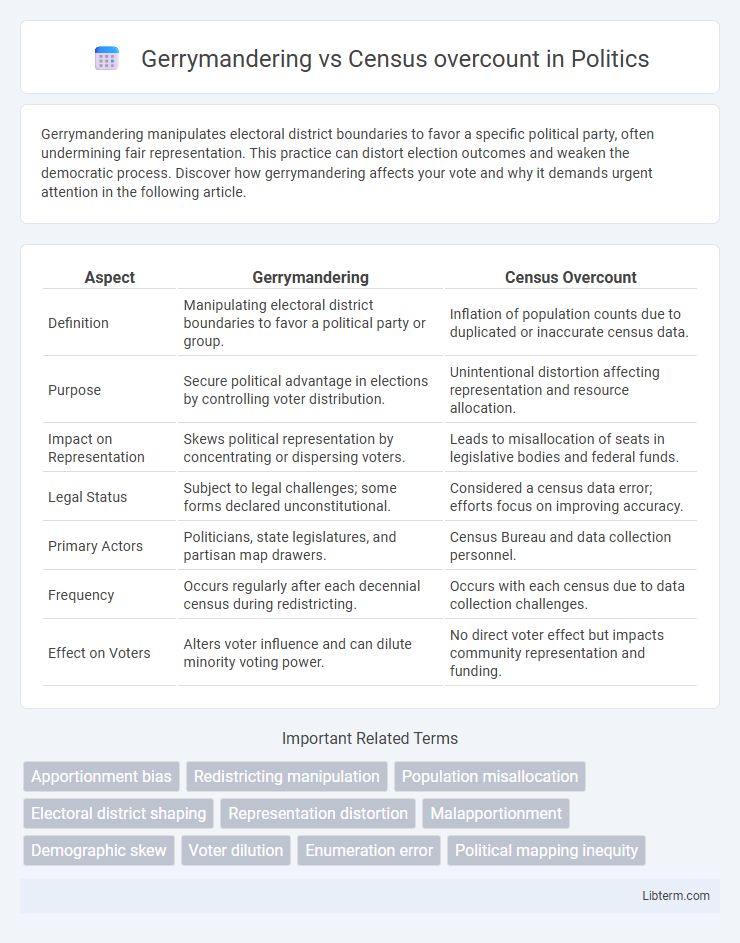Gerrymandering manipulates electoral district boundaries to favor a specific political party, often undermining fair representation. This practice can distort election outcomes and weaken the democratic process. Discover how gerrymandering affects your vote and why it demands urgent attention in the following article.
Table of Comparison
| Aspect | Gerrymandering | Census Overcount |
|---|---|---|
| Definition | Manipulating electoral district boundaries to favor a political party or group. | Inflation of population counts due to duplicated or inaccurate census data. |
| Purpose | Secure political advantage in elections by controlling voter distribution. | Unintentional distortion affecting representation and resource allocation. |
| Impact on Representation | Skews political representation by concentrating or dispersing voters. | Leads to misallocation of seats in legislative bodies and federal funds. |
| Legal Status | Subject to legal challenges; some forms declared unconstitutional. | Considered a census data error; efforts focus on improving accuracy. |
| Primary Actors | Politicians, state legislatures, and partisan map drawers. | Census Bureau and data collection personnel. |
| Frequency | Occurs regularly after each decennial census during redistricting. | Occurs with each census due to data collection challenges. |
| Effect on Voters | Alters voter influence and can dilute minority voting power. | No direct voter effect but impacts community representation and funding. |
Understanding Gerrymandering: Definition and Impact
Gerrymandering involves the deliberate manipulation of electoral district boundaries to favor a specific political party or group, often leading to unrepresentative election outcomes. This practice skews political power by diluting the voting strength of certain populations, undermining democratic principles and fair representation. Accurate census data is crucial to counter gerrymandering, as overcounts can distort population figures, resulting in misallocated resources and imbalanced districting.
Census Overcount: Causes and Consequences
Census overcount occurs when individuals are counted more than once or when populations are inaccurately reported due to data collection errors, such as duplicate responses or misclassification of group quarters. Causes include methodological issues, response bias, and difficulties in tracking transient populations or recent movers. Consequences of census overcount impact political representation, leading to skewed district boundaries and misallocation of federal funds, exacerbating disparities in public services and infrastructure development.
Historical Context: Gerrymandering and Census Overcount in the U.S.
Gerrymandering and census overcount have historically shaped political representation in the U.S., influencing district boundaries and population data accuracy. The 1812 Louisiana redistricting highlighted early gerrymandering tactics, while census overcounts have periodically skewed resource allocation, such as the significant overcount in the 1990 Census. These practices collectively impacted electoral fairness, emphasizing the ongoing challenge of maintaining equitable representation.
How District Boundaries Influence Representation
District boundaries shaped by gerrymandering manipulate electoral outcomes by concentrating or diluting specific voting populations, skewing representation away from the actual demographic distribution. Census overcount further complicates this by inflating population figures in certain areas, which can distort apportionment and resource allocation, amplifying disparities in political influence. The interplay between manipulated boundaries and inaccurate census data ultimately undermines equitable representation in legislative bodies.
Census Data Accuracy: Methods and Challenges
Census data accuracy directly impacts the fairness of electoral district boundaries, with gerrymandering exploiting inaccuracies to skew political representation. Methods such as address canvassing, differential privacy algorithms, and post-enumeration surveys aim to improve data quality, but challenges like undercounting minority populations and nonresponse bias persist. Reliable census counts are crucial for equitable redistricting, requiring continuous methodological advancements and transparent data verification processes.
Political Power: Manipulation vs. Miscalculation
Gerrymandering strategically manipulates political power by redrawing district boundaries to favor specific parties or candidates, often resulting in disproportionate representation that undermines electoral fairness. In contrast, census overcount causes political power miscalculation by inflating population figures in certain areas, leading to inaccurate allocation of congressional seats and federal resources. Both phenomena distort democratic processes, but gerrymandering is an intentional act to control political outcomes, whereas census overcount stems from statistical errors affecting representation equity.
Legal Perspectives on Gerrymandering and Census Errors
Legal perspectives on gerrymandering emphasize the constitutional challenges related to equal representation and voting rights, often scrutinizing district maps for racial or partisan bias. Census overcount errors complicate legal redistricting by inflating population data, potentially skewing representation and resource allocation across legislative districts. Courts frequently grapple with distinguishing intentional gerrymandering from census inaccuracies, impacting rulings on redistricting validity and compliance with the Voting Rights Act.
Socioeconomic Implications of Population Miscounts
Population miscounts caused by census overcounts or undercounts exacerbate the effects of gerrymandering by distorting electoral districts and resource allocation. Socioeconomic implications include unequal political representation, reduced funding for education, healthcare, and public services in marginalized communities, and the perpetuation of systemic disparities. Correcting these inaccuracies is essential to ensure fair democratic processes and equitable distribution of social and economic benefits.
Reform Efforts: Addressing Both Issues
Reform efforts targeting gerrymandering and census overcount emphasize improving accuracy and fairness in political representation by implementing independent redistricting commissions and enhancing census data verification processes. Advanced statistical techniques and community-led audits help identify and correct distortions caused by biased district boundaries and population miscounts. Collaborative policies promote transparency and accountability, ensuring equitable resource allocation and legislative representation for all demographic groups.
Future Outlook: Ensuring Fair Representation
Addressing gerrymandering and census overcount is critical for ensuring fair political representation in future elections. Advances in data analytics and transparent redistricting processes can help detect and prevent manipulative boundary drawing, while improving census accuracy through enhanced outreach and technology reduces population miscounts. Continued collaboration between government agencies, independent watchdogs, and community organizations will be essential to uphold democratic integrity and equitable representation.
Gerrymandering Infographic

 libterm.com
libterm.com